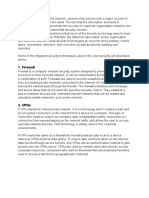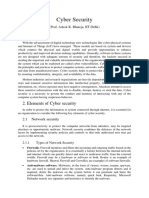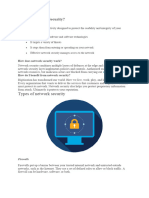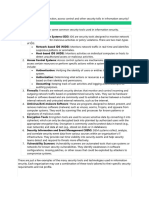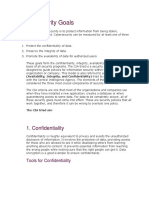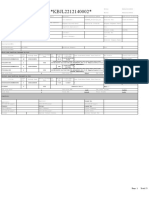0 ratings0% found this document useful (0 votes)
13 viewsCloud Security Tools
Cloud Security Tools
Uploaded by
Niranjan GThis document discusses five common cloud security tools: 1) Firewalls such as traditional and web application firewalls that act as barriers between secure internal networks and untrusted external networks. 2) Intrusion detection systems including network-based and host-based systems that monitor traffic for suspicious activities. 3) Encryption tools that protect data at rest and in transit with standards like AES-256. 4) Identity and access management tools that manage user authentication, permissions, and roles for access control. 5) Security information and event management tools that collect and analyze data across an organization's infrastructure to identify security incidents in real time.
Copyright:
© All Rights Reserved
Available Formats
Download as TXT, PDF, TXT or read online from Scribd
Cloud Security Tools
Cloud Security Tools
Uploaded by
Niranjan G0 ratings0% found this document useful (0 votes)
13 views1 pageThis document discusses five common cloud security tools: 1) Firewalls such as traditional and web application firewalls that act as barriers between secure internal networks and untrusted external networks. 2) Intrusion detection systems including network-based and host-based systems that monitor traffic for suspicious activities. 3) Encryption tools that protect data at rest and in transit with standards like AES-256. 4) Identity and access management tools that manage user authentication, permissions, and roles for access control. 5) Security information and event management tools that collect and analyze data across an organization's infrastructure to identify security incidents in real time.
Original Title
Cloud_Security_Tools
Copyright
© © All Rights Reserved
Available Formats
TXT, PDF, TXT or read online from Scribd
Share this document
Did you find this document useful?
Is this content inappropriate?
This document discusses five common cloud security tools: 1) Firewalls such as traditional and web application firewalls that act as barriers between secure internal networks and untrusted external networks. 2) Intrusion detection systems including network-based and host-based systems that monitor traffic for suspicious activities. 3) Encryption tools that protect data at rest and in transit with standards like AES-256. 4) Identity and access management tools that manage user authentication, permissions, and roles for access control. 5) Security information and event management tools that collect and analyze data across an organization's infrastructure to identify security incidents in real time.
Copyright:
© All Rights Reserved
Available Formats
Download as TXT, PDF, TXT or read online from Scribd
Download as txt, pdf, or txt
0 ratings0% found this document useful (0 votes)
13 views1 pageCloud Security Tools
Cloud Security Tools
Uploaded by
Niranjan GThis document discusses five common cloud security tools: 1) Firewalls such as traditional and web application firewalls that act as barriers between secure internal networks and untrusted external networks. 2) Intrusion detection systems including network-based and host-based systems that monitor traffic for suspicious activities. 3) Encryption tools that protect data at rest and in transit with standards like AES-256. 4) Identity and access management tools that manage user authentication, permissions, and roles for access control. 5) Security information and event management tools that collect and analyze data across an organization's infrastructure to identify security incidents in real time.
Copyright:
© All Rights Reserved
Available Formats
Download as TXT, PDF, TXT or read online from Scribd
Download as txt, pdf, or txt
You are on page 1of 1
Cloud Security Tools
1. Firewalls
- Traditional and Web-Application Firewalls
2. Intrusion Detection Systems (IDS)
- Network-based and Host-based IDS
3. Encryption Tools
- Data-at-rest and Data-in-transit encryption
4. Identity and Access Management (IAM)
- User authentication and permissions
5. Security Information and Event Management (SIEM)
- Real-time analysis of security alerts
Cloud Security Tools
1. Firewalls
Traditional and Web-Application Firewalls: Firewalls act as a barrier between your
secure internal network and untrusted external networks such as the internet.
Traditional firewalls filter traffic based on port and protocol, providing a basic
level of security. Web-Application Firewalls (WAFs) offer more advanced features,
including the ability to filter content, block malicious traffic, and provide
protection against specific types of attacks like SQL injection and Cross-Site
Scripting (XSS).
2. Intrusion Detection Systems (IDS)
Network-based and Host-based IDS: Intrusion Detection Systems monitor network
traffic for suspicious activities. Network-based IDS are positioned at strategic
points within the network to monitor inbound and outbound traffic. Host-based IDS,
on the other hand, are installed on individual systems to monitor local events.
Both types are crucial for identifying potentially harmful activities and can be
integrated with other security tools for a more comprehensive security posture.
3. Encryption Tools
Data-at-rest and Data-in-transit Encryption: Encryption tools are essential for
safeguarding sensitive data. Data-at-rest encryption protects stored data, such as
databases and files, from unauthorized access. Data-in-transit encryption secures
data as it moves between locations, devices, or applications. Advanced encryption
standards like AES-256 are commonly used to provide robust security.
4. Identity and Access Management (IAM)
User Authentication and Permissions: IAM tools help manage identities and their
permissions within a network. They provide features like multi-factor
authentication, single sign-on, and role-based access control. These tools are
essential for ensuring that only authorized individuals have access to specific
resources within the cloud environment.
5. Security Information and Event Management (SIEM)
Real-time Analysis of Security Alerts: SIEM tools collect and analyze data from
various sources within an organization's technology infrastructure. They provide
real-time analysis of security alerts generated by hardware and software. By
correlating different data points, SIEM tools can help identify abnormal patterns
and potential security incidents, enabling quicker response times.
You might also like
- 12 D 68 A 55Document146 pages12 D 68 A 55khanhnam100% (1)
- Coffee Shop Management System C#Document43 pagesCoffee Shop Management System C#abhi61% (31)
- CS Mid 2 AnsDocument26 pagesCS Mid 2 Ansniharikamothey9160No ratings yet
- WINSEM2023-24 BCSE354E ETH VL2023240501599 2024-02-24 Reference-Material-IDocument17 pagesWINSEM2023-24 BCSE354E ETH VL2023240501599 2024-02-24 Reference-Material-ILet's Hear it the other wayNo ratings yet
- Network SecurityDocument24 pagesNetwork SecurityTee ZeeNo ratings yet
- Unit 4Document20 pagesUnit 4Aniket Nsc0025No ratings yet
- CNS Unit 1Document56 pagesCNS Unit 1vinaydarling063No ratings yet
- 7-Module 2-22-02-2024Document41 pages7-Module 2-22-02-2024theorphicarcaneNo ratings yet
- 4-Module - 2 Security Device Management-18!01!2024Document58 pages4-Module - 2 Security Device Management-18!01!2024shreemanjulaaNo ratings yet
- Security Technology - Firewall and VPN, Intrusion Detection System, Access ControlDocument3 pagesSecurity Technology - Firewall and VPN, Intrusion Detection System, Access ControlDev SharmaNo ratings yet
- Network Security Devices and Their Relationship With Information SecurityDocument6 pagesNetwork Security Devices and Their Relationship With Information Securitymeghrajmal2015No ratings yet
- Lect 6 Security of Network, Systems, ApplicationsDocument28 pagesLect 6 Security of Network, Systems, ApplicationscatizfavsNo ratings yet
- Cyber Security: (Prof. Ashok K. Bhateja, IIT Delhi)Document10 pagesCyber Security: (Prof. Ashok K. Bhateja, IIT Delhi)Jatin GoyalNo ratings yet
- Edge SecurityDocument2 pagesEdge SecurityTesfalem FekaduNo ratings yet
- What Is Network SecurityDocument28 pagesWhat Is Network SecurityTamannaNo ratings yet
- Cybersecurity Analyst Interview Questions and AnswersDocument21 pagesCybersecurity Analyst Interview Questions and AnswersDhanraj chavanNo ratings yet
- CS IssDocument2 pagesCS IssAmmar Arhab AbdullahNo ratings yet
- Is Unit5Document43 pagesIs Unit5Sudharsan BalaNo ratings yet
- internet securityDocument3 pagesinternet securityshairafzalNo ratings yet
- Unit-4 Info SecuDocument8 pagesUnit-4 Info Secuworkwithasr04No ratings yet
- WINSEM2022-23 CSE3502 ETH VL2022230503144 Reference Material I 04-01-2023 Lect 7Document24 pagesWINSEM2022-23 CSE3502 ETH VL2022230503144 Reference Material I 04-01-2023 Lect 7Chaitanya KalraNo ratings yet
- Cyber_Security_unit_4Document4 pagesCyber_Security_unit_4khalog712No ratings yet
- CS Chapter 5 UPDocument17 pagesCS Chapter 5 UPidrisabdurazek0123No ratings yet
- Lect 7Document67 pagesLect 7shirto cubherNo ratings yet
- MIS Contemporary Topics (Part 02)Document9 pagesMIS Contemporary Topics (Part 02)Sabrina SifatNo ratings yet
- Unit FirstDocument17 pagesUnit FirstTamannaNo ratings yet
- Network Defense Skill LiftDocument4 pagesNetwork Defense Skill LiftblackneilarmstrongNo ratings yet
- Dbms NotesDocument9 pagesDbms Notespriyanka.debnath.cse.2021No ratings yet
- Cybersecurity-Protecting-Our-Digital-WorldDocument15 pagesCybersecurity-Protecting-Our-Digital-Worldsahdevsingh2633No ratings yet
- Cloud_Security__1709963031Document8 pagesCloud_Security__1709963031z2v4qghmdtNo ratings yet
- Network Security-OSIDocument5 pagesNetwork Security-OSIsonalNo ratings yet
- Protecting Information ResourcesDocument5 pagesProtecting Information ResourcesRea RetodoNo ratings yet
- CS IssDocument2 pagesCS IssAmmar Arhab AbdullahNo ratings yet
- CyberSecurity Week 4 IsmailDocument5 pagesCyberSecurity Week 4 Ismailoluwaseun niyi opeyemiNo ratings yet
- Risk ManagementDocument10 pagesRisk Managementneyoxaw624No ratings yet
- Cyber SecurityDocument9 pagesCyber Securitymaduhkelly1No ratings yet
- Cybersec 1 2Document7 pagesCybersec 1 2MOHIT ELECTROVISION FBDNo ratings yet
- Overview of CybersecurityDocument3 pagesOverview of Cybersecurityer.kevinsevenNo ratings yet
- Cognate 3Document2 pagesCognate 3Faith DumanopNo ratings yet
- Soc Interview Questions and Answers CYBER SECURITY ANALYSTDocument25 pagesSoc Interview Questions and Answers CYBER SECURITY ANALYSTelias kariuki100% (2)
- NETWORKSECURITYDocument4 pagesNETWORKSECURITYytbarekukNo ratings yet
- Cyber securityDocument4 pagesCyber securityPriya acharyaNo ratings yet
- Network Security Note Chapter 1Document20 pagesNetwork Security Note Chapter 1Chong DaxiongNo ratings yet
- Chapter 5 Network SecurityDocument17 pagesChapter 5 Network SecurityLloyd VegafriaNo ratings yet
- Network SecurityDocument29 pagesNetwork Securitywaniaye derickNo ratings yet
- DocumentDocument13 pagesDocumentAshley Mae CaballeroNo ratings yet
- Cyber Security Goals: 1. ConfidentialityDocument12 pagesCyber Security Goals: 1. Confidentialitydoctorbabu01430 949043101111No ratings yet
- Dire Dawa University: College of Computing Department of Computer ScienceDocument8 pagesDire Dawa University: College of Computing Department of Computer ScienceAhadu techNo ratings yet
- Incident Response ProcessDocument14 pagesIncident Response ProcessvanessaNo ratings yet
- Sailpoint Training Understanding ReportDocument2 pagesSailpoint Training Understanding ReportKunalGuptaNo ratings yet
- Design of Security ArchitectureDocument6 pagesDesign of Security ArchitectureAnusha KNo ratings yet
- Foundations of Cyber NotesDocument4 pagesFoundations of Cyber NotesalexanderclinkettNo ratings yet
- CISA CH 5 - Protection of InfoDocument4 pagesCISA CH 5 - Protection of InfoBryan Paul InocencioNo ratings yet
- NF Lecture 14Document10 pagesNF Lecture 14Ayesha nawazNo ratings yet
- Cybersecurity Topics OverviewDocument4 pagesCybersecurity Topics OverviewMedisetti VeerababuNo ratings yet
- Topic 2. Network SecurityDocument5 pagesTopic 2. Network SecurityRosetephanie ZalunNo ratings yet
- MisDocument19 pagesMisRea RetodoNo ratings yet
- Cyber SecurityDocument7 pagesCyber SecurityKshama PathakNo ratings yet
- ImpDocument85 pagesImpAbhiNo ratings yet
- Chapter 6Document7 pagesChapter 6psoubhagya07No ratings yet
- Unit 2 (CL)Document15 pagesUnit 2 (CL)onlyfortest124No ratings yet
- Cryptography and Data Security Book 1: Proper Guide to Data Security in Communication Networks. Cryptography and Data Security in PracticeFrom EverandCryptography and Data Security Book 1: Proper Guide to Data Security in Communication Networks. Cryptography and Data Security in PracticeNo ratings yet
- KBJL2212140002 (BJ1 Sbin) (Wl-Dbs5900-Gul-Swap-Zee006 Y) 20221215142032Document5 pagesKBJL2212140002 (BJ1 Sbin) (Wl-Dbs5900-Gul-Swap-Zee006 Y) 20221215142032AVENON MardocheeNo ratings yet
- Assignment 6 DsaDocument6 pagesAssignment 6 Dsaytk5541No ratings yet
- Intro To MVVM: Dareen AlhiyariDocument15 pagesIntro To MVVM: Dareen AlhiyariReziena Inc.No ratings yet
- Implementation of KOHA Integrated Library Management System in Wollega University Main Library, Nekemte, EthiopiaDocument12 pagesImplementation of KOHA Integrated Library Management System in Wollega University Main Library, Nekemte, EthiopiaRoss RamaNo ratings yet
- Create Bus GuideDocument2 pagesCreate Bus GuidesagarNo ratings yet
- Practicedump: Free Practice Dumps - Unlimited Free Access of Practice ExamDocument5 pagesPracticedump: Free Practice Dumps - Unlimited Free Access of Practice ExamManish RanjanNo ratings yet
- Proposal For Research LaboratoryDocument3 pagesProposal For Research Laboratorysomnath.sinhaNo ratings yet
- GPS Tracker User Manual: PrefaceDocument38 pagesGPS Tracker User Manual: PrefaceAli UtreraNo ratings yet
- Schemas for Multidimensional Data ModelsDocument18 pagesSchemas for Multidimensional Data Modelsfaikimutai3No ratings yet
- HW 7Document2 pagesHW 7pskumarvlsipdNo ratings yet
- 3.1 KPUP MS PowerPoint IntroDocument2 pages3.1 KPUP MS PowerPoint IntroLeopoldo Reuteras Morte IINo ratings yet
- BO Missing ImagesDocument33 pagesBO Missing Imagessrimathi1No ratings yet
- Aug 08 2021 Final PBSAI - Membership Application - IndividualDocument2 pagesAug 08 2021 Final PBSAI - Membership Application - IndividualJoey Rivamonte Ched-roviiNo ratings yet
- Bsit-1A: Development Milestones and Key ContributorsDocument10 pagesBsit-1A: Development Milestones and Key ContributorsMariahNo ratings yet
- Airline Reservation System Project ThesisDocument4 pagesAirline Reservation System Project Thesisjenniferlyonswestvalleycity100% (2)
- OOSE Chapter 8Document48 pagesOOSE Chapter 8Sushat KoradaNo ratings yet
- ALU Railways 8 Pages BrochureDocument8 pagesALU Railways 8 Pages BrochureMoez Ben NejmaNo ratings yet
- CLI Interface Guide - 6-66538-002 - RevA - Galaxy 1.2 - DXi7500Document156 pagesCLI Interface Guide - 6-66538-002 - RevA - Galaxy 1.2 - DXi7500FairuzHairiNo ratings yet
- Rps Mini Project Final - RemovedDocument11 pagesRps Mini Project Final - RemovedDhanya SonuNo ratings yet
- AITT ProjectLibre User Guide v1.0Document39 pagesAITT ProjectLibre User Guide v1.0TEX BEACONNo ratings yet
- Prime SenseDocument4 pagesPrime SenseKOSTASPDFNo ratings yet
- CPU and MemoryDocument2 pagesCPU and Memorymantap betulNo ratings yet
- Athik Mohamed: EducationDocument1 pageAthik Mohamed: Educationdummy.athikNo ratings yet
- M I L-ReviewerDocument12 pagesM I L-ReviewerCindy FloresNo ratings yet
- Ron Beaufort Training, LLC Hands-On Technical WorkshopsDocument17 pagesRon Beaufort Training, LLC Hands-On Technical WorkshopsAlexander RiosNo ratings yet
- C-Bus Developers KitDocument3 pagesC-Bus Developers KitPaul RhodesNo ratings yet
- Pearson Java NotesDocument74 pagesPearson Java Noteschiraggupta628No ratings yet
- 133579-Common Problem Solutions For Android PhonesDocument6 pages133579-Common Problem Solutions For Android PhonesAsmie DamtieNo ratings yet









